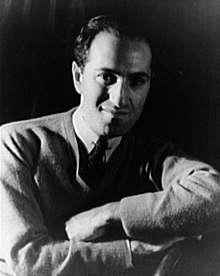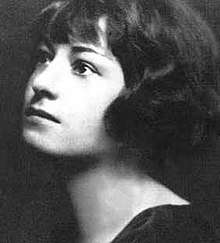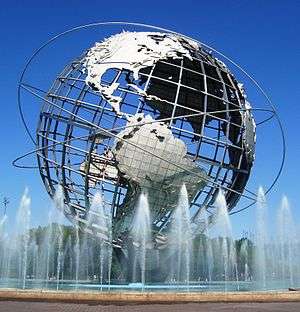Kew Gardens, Queens
| Kew Gardens | |
|---|---|
| Neighborhood of Queens | |
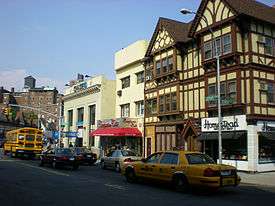 Homestead Gourmet Shop and other stores on Lefferts Boulevard | |
|
Location within New York City | |
| Country |
|
| State |
|
| City |
|
| County/Borough |
|
| Community District | Queens 9[1] |
| Named for | Royal Botanic Gardens, Kew[2] |
| Population (2010 United States Census)[3] | |
| • Total | 23,278 |
| Race/Ethnicity[4] | |
| • White | 49.3% |
| • Hispanic | 24.3% |
| • Asian | 15.6% |
| • Black | 6.5% |
| • Other | 4.3% |
| Economics | |
| • Median income | $61,287 |
| ZIP code | 11415 |
| Area code(s) | 718, 347, 929, and 917 |
| Website |
www |
Kew Gardens is a neighborhood in the central area of the New York City borough of Queens. Kew Gardens, shaped roughly like a triangle, is bounded to the north by Union Turnpike and the Jackie Robinson Parkway (formerly the Interboro Parkway), to the east by Van Wyck Expressway and 131st Street, to the south by Hillside Avenue, and to the west by Park Lane, Abingdon Road, and 118th Street. Forest Park and the neighborhood of Forest Hills are to the west, Flushing Meadows–Corona Park north, Richmond Hill south, Briarwood southeast, and Kew Gardens Hills east.
History
Kew Gardens was one of seven planned garden communities built in Queens from the late 19th century to 1950.[5] Much of the area was acquired in 1868 by Englishman Albon P. Man, who developed the neighborhood of Hollis Hill to the south, chiefly along Jamaica Avenue, while leaving the hilly land to the north undeveloped.[6]
Maple Grove Cemetery on Kew Gardens Road opened in 1875. A Long Island Rail Road station was built for mourners in October and trains stopped there from mid-November. The station was named Hopedale, after Hopedale Hall, a hotel located at what is now Queens Boulevard and Union Turnpike. In the 1890s, the executors of Man's estate laid out the Queens Bridge Golf Course on the hilly terrains south of the railroad. This remained in use until it was bisected in 1908 by the main line of the Long Island Rail Road, which had been moved 600 feet (180 m) to the south to eliminate a curve. The golf course was then abandoned and a new station was built in 1909 on Lefferts Boulevard. Man's heirs, Aldrick Man and Albon Man Jr., decided to lay out a new community and called it at first Kew and then Kew Gardens after the well-known botanical gardens in England.[2] The architects of the development favored English and neo-Tudor styles, which still predominate in many sections of the neighborhood.
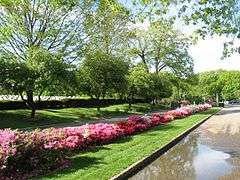
In 1910, the property was sold piecemeal by the estate and during the next few years streets were extended, land graded and water and sewer pipes installed. The first apartment building was the Kew Bolmer at 80–45 Kew Gardens Road, erected in 1915; a clubhouse followed in 1916 and a private school, Kew-Forest School, in 1918. In 1920, the Kew Gardens Inn at the railroad station opened for residential guests, who paid $40 a week for a room and a bath with meals. Elegant one-family houses were built in the 1920s, as were apartment buildings such as Colonial Hall (1921) and Kew Hall (1922) that numbered more than twenty by 1936.
In July 1933, the Grand Central Parkway opened from Kew Gardens to the edge of Nassau County; this road was extended in 1935 as the Interborough Parkway to Pennsylvania Avenue in East New York. Since the parkways used part of the roadbed of Union Turnpike, no houses were demolished. However, the greatest change was wrought by the opening of the Independent Subway System line along Queens Boulevard to Union Turnpike on December 31, 1936; four months later, the subway was extended to Jamaica, Queens. Residents could now reach Manhattan, Brooklyn, and the Bronx twenty-four hours a day for a five-cent fare, stimulating the construction of larger apartment buildings like Kent Manor and high-rise buildings along Queens Boulevard and the last vacant land disappeared.
Despite its historical significance, Kew Gardens lacks any landmark protection.[5]
In 1964, the neighborhood gained news notoriety when Kitty Genovese was murdered near the Kew Gardens Long Island Railroad station. A New York Times article reported that none of the neighbors responded when she cried for help.[7] The story came to represent the apathy and anonymity of urban life. The circumstances of the case are disputed to this day. It has been alleged that the critical fact reported by The New York Times that "none of the neighbors responded" was false. The case of Kitty Genovese is an oft-cited example of the bystander effect, and the case that originally spurred research on this social psychological phenomenon.[8]
In addition to Maple Grove Cemetery, the Ralph Bunche House is listed on the National Register of Historic Places and is also a designated National Historic Landmark.[9]
Area description
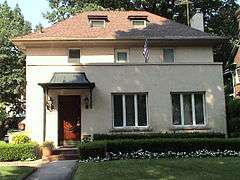

Kew Gardens remains a densely populated residential community, but Kew Gardens is increasingly becoming an upper-class residential area, with a mix of one-family homes above the million-dollar range, complex apartments, co-ops and others converted and on the way or being converted as condominiums. A major five-star hotel is under development on 82nd Avenue, reflecting a modernization of the area. However, it is filled mainly with apartment buildings between four and ten stories high; while many are rentals, some are Housing cooperatives (co-ops). Although there are no New York City Housing Authority complexes in Kew Gardens, Mitchell-Lama buildings provide stabilized rental prices for families or individuals who may need help paying rent. On 83rd Avenue there is a 32-story Mitchell-Lama building. Along the borders of Richmond Hill, Briarwood, and Jamaica, smaller attached houses exist. Many of these are two or three family homes. Expensive single family homes are located around the Forest Park area. Due to constant development, however, many owners are selling out their detached homes to developers who teardown and convert them into apartment housing. This has brought demographic change.
Surrounded by Forest Park, residents in Kew Gardens enjoy what many Manhattanites lack: greenery and quiet nights. The Park, which is very well preserved and is the third largest in Queens, has a private road where residents can jog or walk year round. There are some horse back riding paths and hiking paths actively used by residents. Frederick Law Olmsted conceived the design of the park.[10] Some of the Queens courthouses are also located in Kew Gardens on the side of Queens Boulevard.
The neighborhood also has many airline personnel because of its proximity to the MTA's Q10 bus line to John F. Kennedy International Airport, as well as to Delta Air Lines and other airlines' special shuttles that serve pilots and flight attendants staying in Kew Gardens.
Kew Gardens's commercial center is Lefferts Boulevard between Austin Street and Metropolitan Avenue. Major attractions include the large sports bar Austin's Ale House, the Village Diner, and Kew Gardens Cinemas, a 1930s art deco movie theater that has been converted into a six-screen multiplex and shows a mix of commercial, independent, and foreign films. [11] The Kew Gardens Festival of Cinema premiered in 2017, and will return in 2018 with plans to become an annual tradition.[12] Lefferts is also home to the only bookstore in central Queens, Kew & Willow Books.[13]
The county's civic center, Queens Borough Hall, along with one of the county criminal courts, stand at the northern end of the neighborhood, on Queens Boulevard, in a complex extending from Union Turnpike to Hoover Avenue.
Schools of note located in Kew Gardens include Yeshiva Tifereth Moshe, Bais Yaakov of Queens and Yeshiva Shaar Hatorah. P.S. 99, the local public school, has special programs for gifted students such as the Gifted and Talented program, where children start to learn advanced material beginning in second grade.[14]
Demographics
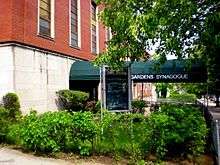
Based on data from the 2010 United States Census, the population of Kew Gardens was 23,278, a decrease of 610 (2.6%) from the 23,888 counted in 2000. Covering an area of 469.74 acres (190.10 ha), the neighborhood had a population density of 49.6 inhabitants per acre (31,700/sq mi; 12,300/km2).[3]
The racial makeup of the neighborhood was 49.3% (11,478) White, 6.5% (1,515) African American, 0.2% (37) Native American, 15.6% (3,628) Asian, 0.0% (11) Pacific Islander, 1.1% (257) from other races, and 3.0% (701) from two or more races. Hispanic or Latino of any race were 24.3% (5,651) of the population.[4]
As of the 2000 United States Census, the demographics were 66.2% White, 13.0% Asian, 7.0% Black or African American, 0.3% American Indian and Alaska Native, 7.4%. Other and Hispanic or Latino were 20.0% of the population. The neighborhood's demographics have since changed, however. The Hispanic and Asian populations have grown significantly over the past decade. In 2008, U.S. Census estimates placed the Kew Gardens population at more than 25,769.[15] Many of the residents are between the ages of 30 and 38, married, college graduates and renters.
Kew Gardens has the highest percentage of residents who work from home in the borough of Queens. Kew Gardens has 4.5% of employed residents who work from home.[16]
Kew Gardens is ethnically diverse. A large community of Jewish refugees from Germany took shape in the area after the Second World War which is reflected still today by the number of active synagogues in the area. The neighborhood attracted many Chinese immigrants after 1965, about 2,500 Iranian Jews arrived after the Iranian Revolution of 1979, and immigrants from China, Pakistan, Iran, Afghanistan, Israel, the former Soviet Union, India, Bangladesh and Korea settled in Kew Gardens during the 1980s and 1990s. Currently, Kew Gardens has a growing population of Bukharian Jews from Uzbekistan, alongside a significant Orthodox Jewish community.[6] Also many immigrants from Central America, and South America call Kew Gardens home, as well as immigrants from Japan.
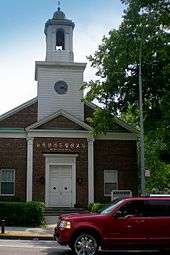
The increase of the Korean population followed the renovation and rededication of the First Church of Kew Gardens, which offers Korean-language services. In recent years, young professionals and Manhattanites looking for greenery, park-like atmosphere and spacious apartments have moved to the area.
Major development in the neighborhood, such as the construction of new apartment complexes and multi-family homes, has resulted in great demographic change as well. Immigrants from Latin America, Guyana, South Asia and East Asia, and the Middle East (especially Israel), have moved into these new developments. Even the local cuisine reflects this diversity in Kew Gardens, with Russian, Italian, Indian, Pakistani, and Uzbek dining available to residents and visitors. Food outlets include restaurants, delis, and markets. Small diners, Indian restaurants, Spanish restaurants, Caribbean restaurants, European and Arab Minimarkets, and Kosher delis line the streets of Kew Gardens. Many religious groups such as Jews, Muslims, and Hindus, can shop at local markets and bazaars that cater to their religious-food needs.
Economy
Kew Gardens has many locally owned businesses and restaurants especially on Lefferts Boulevard, Metropolitan Avenue, Austin Street, and Kew Gardens Road. The courthouse is very profitable, as is transportation to the area; however, neither profit the neighborhood directly, but instead serve as an incentive to move to the area. The cost of living in the neighborhood (as of 2015) is $62,900.[17] Pilots and flight attendants who stay in Kew Gardens in between John F. Kennedy International Airport and LaGuardia Airport flights also affect the local economy.
Saudi Arabian Airlines operates an office in Suite 401 at 80–02 Kew Gardens Road in Kew Gardens.[18]
Transportation
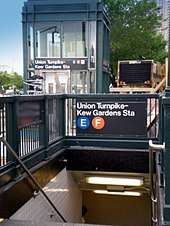
The neighborhood is served by the New York City Subway's E and F trains at the Kew Gardens–Union Turnpike subway station, and by the Long Island Rail Road's City Terminal Zone at the Kew Gardens station.[19] New York City Bus routes include Q10, Q37, Q46, Q54 and Q60, as well as several express bus routes to Manhattan.[20]
The neighborhood is accessible by car from Interstate 678 (Van Wyck Expressway), Grand Central Parkway, Jackie Robinson Parkway, Queens Boulevard, and Union Turnpike. These all intersect at the Kew Gardens Interchange.[19]
Notable people
Notable residents of Kew Gardens include:
- Grace Albee (1890-1985), printmaker and wood engraver.[21]
- Burt Bacharach (born 1928) Award-winning pianist, composer and producer grew up in Kew Gardens.[22]
- Crosby Bonsall (1921–1995) artist and children's book author and illustrator.[23]
- Maud Ballington Booth (1865–1948), Volunteers of America co-founder.[24]
- Joshua Brand (born 1950), television writer, director and producer, grew up in Kew Gardens.[25]
- Ralph Bunche (1903–1971), diplomat and Nobel Peace Prize winner.[26]
- Rudolf Callmann (1892-1976), German American legal scholar and expert in the field of German and American competition law who assisted Jewish refugees from Nazi Germany.[27]
- Ron Carey (1936-2008), labor leader who served as president of the International Brotherhood of Teamsters from 1991 to 1997.[28]
- Charlie Chaplin (1889-1977), actor, lived at 105 Mowbray Drive in 1919–1922.[29]
- Rodney Dangerfield (1921–2004), comedian who lived above the Austin Ale House.[30]
- Rona Elliot (born 1947), music journalist, grew up in Kew Gardens.[31]
- Lloyd Espenschied (1889-1986), electrical engineer who co-invented the modern coaxial cable.[32]
- George Gershwin (1898–1937), composer.[33]
- Bernhard Goetz (born 1947), best known for shooting four young black men on the subway in 1984.[34]
- Ladislav Hecht (1909-2004), Jewish professional tennis player, well known for representing Czechoslovakia in the Davis Cup during the 1930s.[35]
- Miriam Hopkins (1902–1972), actress.[36]
- Frederick Jagel (1897-1982), tenor, primarily active at the Metropolitan Opera in the 1930s and 1940s.[37]
- Rabbi Paysach Krohn (born 1945), rabbi and author, currently lives in Kew Gardens.[38]
- Norman Lewis (1915–2006), Olympic fencer
- Josef Lhevinne (1874–1944), concert pianist.[39][40]
- Rosina Lhévinne (1880-1976), pianist and pedagogue.[41]
- Robert H. Lieberman, filmmaker, grew up in Kew Gardens.[42]
- Saul Marantz (1911-1997), designed and built the first Marantz audio product at his home in Kew Gardens.[43]
- Peter Mayer (1936-2018), former Penguin Books CEO, grew up in Kew Gardens.[44]
- Anaïs Nin (1903–1977), author.[39]
- Dorothy Parker (1893–1967), poet.[33]
- Will Rogers, Sr. (1879–1935), actor.[33]
- Will Rogers, Jr. (1911–1993), congressman and son of Will Rogers, Sr..[29]
- Nelson Saldana, track cycling champion.[45]
- Ossie Schectman (1919-2013), basketball guard, who is credited with having scored the first basket in the Basketball Association of America (BAA), which would later become the National Basketball Association (NBA).[46]
- Robert Schimmel (1950-2010), comedian, grew up in Kew Gardens.[47]
- Jerry Springer (born 1944), talk show host and former mayor of Cincinnati, Ohio.[48]
- Paul Stanley (born 1952), musician, singer, songwriter and painter best known for being the rhythm guitarist and singer of the rock band Kiss.[49]
- Carol Montgomery Stone (1915-2011), actress and daughter of actor Fred Stone, grew up in Kew Gardens.[29]
- Sim Van der Ryn, architect, researcher and educator, who has applied principles of physical and social ecology to architecture and environmental design.[50]
- Dick Van Patten (1928-2015), actor, best known for his role on the television comedy-drama Eight Is Enough.[51]
- S. Howard Voshell (1888–1937), professional tennis player and later a promoter.[52]
- Robert C. Wertz (1932-2009), politician who served for 32 years as a member of the New York State Assembly.[53]
Gallery
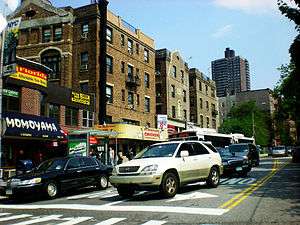 Shops on Kew Gardens Road
Shops on Kew Gardens Road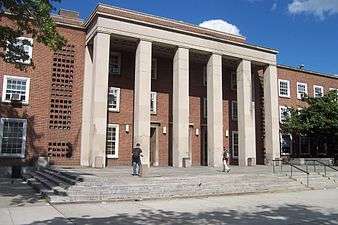 Queens Borough Hall
Queens Borough Hall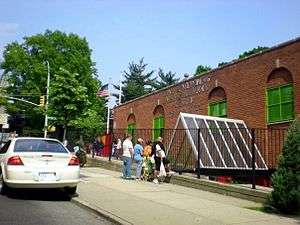 P.S. 99 school annex
P.S. 99 school annex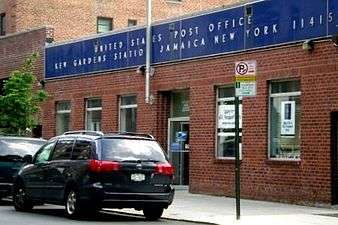 Kew Gardens Post Office
Kew Gardens Post Office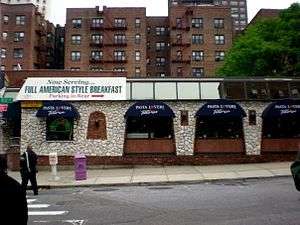 A restaurant in Kew Gardens; the adjacent site would become a five-star hotel
A restaurant in Kew Gardens; the adjacent site would become a five-star hotel
See also

References
- ↑ "NYC Planning | Community Profiles". communityprofiles.planning.nyc.gov. New York City Department of City Planning. Retrieved April 7, 2018.
- 1 2 "Next to the L.I.R.R. Tracks; Five 2-Family Houses For Kew Gardens", The New York Times, April 24, 1994. Accessed August 27, 2018. "In 1909, when train service began on the Long Island Rail Road, the northerly section of the Man property was renamed Kew Gardens, also after a section of London."
- 1 2 Table PL-P5 NTA: Total Population and Persons Per Acre - New York City Neighborhood Tabulation Areas*, 2010, Population Division - New York City Department of City Planning, February 2012. Accessed June 16, 2016.
- 1 2 Table PL-P3A NTA: Total Population by Mutually Exclusive Race and Hispanic Origin - New York City Neighborhood Tabulation Areas*, 2010, Population Division - New York City Department of City Planning, March 29, 2011. Accessed June 14, 2016.
- 1 2 "New York Real Estate: Kew Gardens", AM New York, August 28, 2008. Accessed July 4, 2009.
- 1 2 Donovan, Aaron. "If You're Thinking of Living In/Kew Gardens, Queens; Small-Town Feeling at a Busy Crossroads", The New York Times, October 15, 2000. Accessed August 27, 2018.
- ↑ A Picture History of Kew Gardens, NY – Kitty Genovese – The popular account of the Kitty Genovese murder is mostly wrong as shown by the evidence from her killer's trial and other sources Archived April 3, 2009, at the Wayback Machine.
- ↑ Dowd, Maureen. "20 Years After The Murder Of Kitty Genovese, The Question Remains: Why?", The New York Times, March 12, 1984. Accessed August 27, 2018.
- ↑ National Park Service (2010-07-09). "National Register Information System". National Register of Historic Places. National Park Service.
- ↑ "Forest Park: History", New York City Department of Parks & Recreation, July 2009. Accessed July 4, 2009.
- ↑ "Cinema Treasures- Kew Gardens Cinemas", November 2017. Accessed November 15, 2017.
- ↑ "Kew Gardens Film Festival to Return in 2018 Following Successful Inaugural Event", November 2017. Accessed November 15, 2017.
- ↑ "Kew Gardens to Get Its First Bookstore in Decades" Archived November 9, 2017, at the Wayback Machine., May 2017. Accessed May 24, 2017.
- ↑ "P.S. 99 Kew Gardens School", Inside Schools, September 2006. Accessed July 4, 2009.
- ↑ "Kew Gardens—Quiet and Leafy Location" Archived October 4, 2009, at the Wayback Machine., Queens Chronicle, June 12, 2008. Accessed July 4, 2009.
- ↑ "Working From Home in Queens, NYC". The Austin Space. Retrieved April 16, 2017.
- ↑ http://www.realtor.com/local/Kew-Gardens_New-York_NY
- ↑ "Ministry Addresses in the U.S. Archived 3 January 2009 at the Wayback Machine.." Embassy of Saudi Arabia Washington D.C. Accessed on January 5, 2008.
- 1 2 "MTA Neighborhood Maps: Kew Gardens" (PDF). mta.info. Metropolitan Transportation Authority. 2018. Retrieved October 1, 2018.
- ↑ "Queens Bus Map" (PDF). Metropolitan Transportation Authority. December 2017. Retrieved April 24, 2018.
- ↑ "The Professionalization of An American Woman Printmaker: The Early Career of Grace Albee, 1915 – 1934", Georgetown University Library, March 22, 2005. Accessed November 28, 2017. "These graphic works, created between 1915 and 1983, record her careful observations of her surroundings near the various locales in which she lived: Providence (1915–1928); Paris (1928–1933); New York City (1933–1938); Bucks County, Pennsylvania (1938–1962); Kew Gardens, New York (1962–1974); and finally in Barrington and Bristol, Rhode Island (1974–1983)."
- ↑ Cossar, Neil. "This Day in Music, May 12: Burt Bacharach, Neil Young; Burt Bacharach celebrates his 83rd birthday, Neil Young gets an eight-legged claim to fame.", The Morton Report, May 11, 2011. Accessed November 28, 2017. "The son of nationally syndicated columnist Bert Bacharach, Burt moved with his family in 1932 to Kew Gardens in Queens, New York. At his mother's insistence, he studied cello, drums, and then piano beginning at the age of 12."
- ↑ Staff. "Crosby Bonsall, 74, Children's Author", The New York Times, January 20, 1995. Accessed November 28, 2017. "She was born in Kew Gardens, Queens, and studied at the New York University School of Architecture and the American School of Design."
- ↑ "Gift To Maud B. Booth.; Charles D. Stickney Leaves Residuary Estate to Head of Volunteers.", The New York Times, March 31, 1916. Accessed July 5, 2009. "Charles Dickinson Stickney, a prominent lawyer of this city, who died on March 8, did not provide in his will for twelve first cousins, two second cousins, and one aunt, but bequeathed his entire residuary estate to Mrs. Maud Booth, widow of Ballington Booth and head of the Volunteers of America, who lives in Kew Gardens, L.I."
- ↑ Chan, Sewell. "Nazi Refugees’ Son Explores Complex Feelings", New York Times, April 22, 2009. Accessed July 5, 2009. "Growing up in Kew Gardens, Queens, in the 1940s and '50s, the children of Jewish refugees from Central Europe did not always feel different...Joshua Brand, the writer and producer, a creator of the television hits "St. Elsewhere" and "Northern Exposure"; the architectural historian Barry Lewis."
- ↑ Rimer, Sara. "From Queens Streets, City Hall Seems Very Distant", The New York Times, October 19, 1989. Accessed November 28, 2017. "But in Kew Gardens, a man had to be an Under Secretary General of the United Nations and a Nobel Prize winner to get his street cleared. 'Only one street in the entire community was plowed - Ralph Bunche's street,' said Rabbi Bernard Rosensweig, whose home is not on that now-legendary street where the late Mr. Bunche lived."
- ↑ Staff. "Rudolph Callmann, 83, Dies; Lawyer Aided Jewish Refugees", The New York Times, March 15, 1976. Accessed November 28, 2017. "Dr. Rudolf Callmann, lawyer, author and a leader in aiding Jewish refugees from Nazi Germany, died Friday at his home in Kew Gardens, Queens. He was 83 years old."
- ↑ McFaden, Robert D. "New Teamster Chief's Motto: Honest Work for Honest Pay", The New York Times, December 15, 1991. Accessed November 28, 2017. "Mr. Carey, a former marine and a father of five who buys his suits off the rack, eats tuna sandwiches for lunch, drives a 1989 car and has lived in the same Kew Gardens house for 35 years, is a man who shuns extravagance, stays at budget hotels, carries his own suitcases, accounts for every penny of his expenses and for years has gone daily to the yards to talk to members."
- 1 2 3 Hart, May Gleason. "Kew Gardens of Today – A Far Cry from 50 years Ago", Community News, January 1966. Accessed July 5, 2009. "We have had many prominent people reside in Kew Gardens. Wil [sic] Rogers and his family lived on the opposite corner. Will Rogers, Jr., Mary and Jimmie were my daughter Jeanne's play and schoolmates and were frequently joined by Paula and Carol Stone, daughters of the famous musical comedy star, Fred Stone."
- ↑ Christon, Lawrence. "The Education Of Rodney Dangerfield", Los Angeles Times, July 1, 1986. Accessed April 1, 2008. "Perhaps school talk reminded him of growing up in New York's Kew Gardens, where, as a boy named Jacob Cohen, he had an entertainer father who didn't use the family name (he billed himself as Phil Roy and when Dangerfield went into show business as a comedian, he used the moniker Jack Roy)."
- ↑ Chan, Sewell. "Nazi Refugees’ Son Explores Complex Feelings", New York Times, April 22, 2009. Accessed July 5, 2009. "Growing up in Kew Gardens, Queens, in the 1940s and '50s, the children of Jewish refugees from Central Europe did not always feel different...the pop music critic Rona Elliot; Joshua Brand, the writer and producer, a creator of the television hits "St. Elsewhere" and "Northern Exposure"; the architectural historian Barry Lewis; and, to be sure, countless lawyers and doctors."
- ↑ Cook, Joan. "Lloyd Espnschied, One Of The Inventors Of The Coaxial Cable", The New York Times, July 4, 1986. Accessed November 28, 2017. "Lloyd Espenschied, co-inventor of the coaxial cable, which paved the way for television transmission, died June 21 at a nursing home in Holmdel, N.J. He was 97 years old and lived in Kew Gardens, Queens."
- 1 2 3 Bortolot, Lana. "New York Real Estate: Kew Gardens, Queens" Archived December 1, 2008, at the Wayback Machine., AM New York, August 28, 2008. Accessed July 5, 2009. "The neighborhood's nickname, "Crew Gardens," is a nod to the many airline personnel living here, but Kew Gardens has always been home to the jet set: Charlie Chaplin, Will Rogers, Dorothy Parker and George Gershwin were among the artistic community that settled here in the 1920s."
- ↑ McFadden, Robert D. "Goetz: A Private Man In A Public Debate", The New York Times, January 6, 1985. Accessed November 28, 2017. "Bernhard Hugo Goetz was born at Kew Gardens Hospital in Queens on Nov. 7, 1947, the youngest of four children of Bernhard Willard and Gertrude Goetz."
- ↑ Litsky, Frank. "Ladislav Hecht, 94, a Tactician On the Tennis Courts in the 30's", The New York Times, June 10, 2004. Accessed November 28, 2017. "Ladislav Hecht, once the captain of Czechoslovakia's Davis Cup team and perhaps the best tennis player on the European continent immediately before World War II, died May 27 at home in Kew Gardens, Queens. He was 94."
- ↑ Lewis, Barry. "Kew Gardens: Urban Village in the Big City", April 30, 1999. Accessed July 5, 2009. "Kew Gardens, a village in Queens about twelve miles (19 km) from Manhattan, has been home to movie stars and Broadway performers (Charlie Chaplin, Miriam Hopkins, and Will Rogers), authors (Anaïs Nin and Dorothy Parker), and even Nobel Prize winners (Ralph Bunche). In many ways it has been a community ahead of its time."
- ↑ Staff. "Jagel, Opera Tenor, Is Injured By Auto; Young Metropotitan Singer's Leg Fractured in Accident at Kew Gardens.", The New York Times, December 6, 1930. Accessed November 28, 2017. "Frederick Jagel, the young Metropolitan Opera Company tenor, who rose quickly to fame after his debut four seasons ago, received a multiple fracture of the left leg yesterday afternoon when he was knocked down by an automobile near his home in Kew Gardens while he was crossing Union Turnpike at Queens Boulevard"
- ↑ "The Mohel", July 2009. Accessed July 5, 2009. "He lives in Kew Gardens, NY with his wife Miriam and takes great pride in his family."
- 1 2 "Neighborhood at Risk: Kew Gardens" Archived April 20, 2009, at the Wayback Machine., Historic Districts Council, July 2009. Accessed July 5, 2009. "Kew Gardens became the home of an artistic and intellectual set. In the 1910's and 1920's, neighbors included film and stage stars, writers, musicians, and artists such as Charlie Chaplin, Will Rogers, Anaïs Nin, Dorothy Parker, Joseph Lhevinne, and George Gershwin."
- ↑ "Josef Lhevihhe, 69, Noted Pianist, Dies; Won Wide Acclaim as Soloist and in Recitals With Wife--Made Debut in Moscow at 14", The New York Times, December 3, 1944. Accessed November 28, 2017. "Josef Lhevinne, the pianist, died yesterday afternoon of a heart attack ailment in his home at 119-19 Eighty-third Avenue, Kew Gardens, Queens."
- ↑ Gottlieb, Jane. "Rosina Lhévinne 1880-1976", Jewish Women's Archive. Accessed November 28, 2017. "Immediately after the war, the Lhévinnes immigrated to the United States and settled in Kew Gardens, Queens. In 1924, both were invited to join the faculty of the newly established Juilliard Graduate School."
- ↑ Chan, Sewell. "Nazi Refugees’ Son Explores Complex Feelings", New York Times, April 22, 2009. Accessed July 5, 2009. "Growing up in Kew Gardens, Queens, in the 1940s and '50s, the children of Jewish refugees from Central Europe did not always feel different...Such are the themes of "Last Stop Kew Gardens," a 54-minute semiautobiographical documentary by Robert H. Lieberman, 68, a senior lecturer in physics at Cornell who has branched out into novels and films."
- ↑ Johnson, Lawrence B. "Saul B. Marantz, 85, Pioneer In Hi-Fi Audio Components", The New York Times, January 23, 1997. Accessed August 7, 2016. "After service in the Army during World War II, Mr. Marantz and his wife, Jean Dickey Marantz, settled in Kew Gardens, Queens."
- ↑ Chan, Sewell. "Nazi Refugees’ Son Explores Complex Feelings", New York Times, April 22, 2009. Accessed July 5, 2009. "Michael Nussbaum, a lawyer, and Peter Mayer, the former chief executive of Penguin Books, both recall their acute embarrassment about their German-speaking parents, who sounded just like the Nazis in postwar American films."
- ↑ Staff. "Animal, Guv, Rabbit and Hartnett join Hall; L.V. Velodrome welcomes four riders to the Class of 2006.", The Morning Call, August 17, 2006. Accessed November 28, 2017. "From Kew Gardens, N.Y., Nelson "The Rabbit" Saldana marked a dominant cycling career that began in 1969 with an intermediate national championship victory and featured a gold medal at the 1975 Pan American Games in the Team Pursuit."
- ↑ "Ossie Schechtman, scored first basket in NBA, dies at 94", Jewish Telegraphic Agency, July 30, 2013. Accessed November 28, 2017. "Schechtman, a 6-foot guard from Kew Gardens in Queens, starred at Long Island University, guiding the Blackbirds to an undefeated 1938-39 season and titles in the NIT and NCAA tournaments."
- ↑ Krawitz, Alan. "Kew Gardens — Quiet And Leafy Location" Archived October 4, 2009, at the Wayback Machine., Queens Chronicle, June 12, 2008. Accessed July 5, 2009. "Notable former residents of Kew Gardens include Will Rogers and most recently daytime talk host Jerry Springer. In addition, Kew Gardens has been the subject of numerous books and films, including Barry Lewis' 1999 book, "Kew Gardens: Urban Village in the Big City," and Robert Lieberman's film "Last Stop Kew Gardens," featuring Springer, Josh Brand and comedian Robert Schimmel."
- ↑ Colangelo, Lisa L. "Springer's A Class Act Ps 99 Honors Famed Alum At 75th Anniversary Gala", New York Daily News, December 6, 1999. Accessed November 28, 2017. "Jerry Springer still remembers the morning his parents sent him off to school and begged him to behave. It was open school day at Public School 99 in Kew Gardens, and the rest of his fifth-grade class would be sitting with their parents."
- ↑ Leaf, David; and Sharp, Ken. KISS: Behind the Mask - Official Authorized Biography, p. 25. Grand Central Publishing, 2008. ISBN 9780446553506. Accessed November 28, 2017. "In 1960, the Eisen family moved to Kew Gardens in Queens, not too far away from where the Klein family was living."
- ↑ Sim Van der Ryn (Architect), Pacific Coast Architecture Database. Accessed November 28, 2017. "Van der Ryn left Holland during World War II, living first in the Kew Gardens neighborhood of Queens, NY, and then moved to Great Neck, NY, also on Long Island."
- ↑ Colker, David. "Dick Van Patten dies at 86; 'Eight is Enough' star, pet food firm co-founder", Los Angeles Times, June 23, 2015. Accessed November 28, 2017. "He was born on Dec. 9, 1928, in the Kew Gardens neighborhood of Queens in New York City."
- ↑ Staff. "S. Howard Voshell, Ex-Tennis Star, 49; National Indoor Champion in 1917 and 1918 Succumbs at Home in Kew Gardens", The New York Times, November 11, 1937. Accessed November 28, 2017. "S. Howard Voshell, a former "first ten" man in the national tennis ranking, who held the national indoor championship in 1917 and 1918, died yesterday at his home, 32 Abingdon Road, Kew Gardens, Queens, after an illness of six months."
- ↑ Brand, Rick. "Robert Wertz, longtime GOP assemblyman, dead at 76", Newsday, May 5, 2009. Accessed November 28, 2017. "Born in Kew Gardens, Queens, Wertz graduated from Sewanhaka High School in Floral Park and got a bachelor's degree from upstate Alfred University and a law degree from Albany Law School."
External links
| Wikimedia Commons has media related to Kew Gardens, Queens. |
